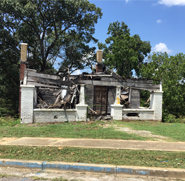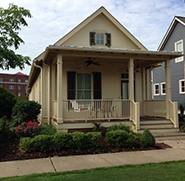HCI Domains and Indicators
The Healthy Communities Assessment Tool (HCAT) provides planners, community development and neighborhood advocates, and policy makers an understandable way to evaluate community health. The HCAT provides a cumulative ranking of the social, physical and economic environment of every neighborhood based on Healthy Community Index (HCI) core indicators: the higher the rank (i.e., 1 is best), the more supportive the community is of human health and well-being. For example, a neighborhood with an HCAT score of 26 (out of 55 neighborhoods) could be considered to be healthier or have better health prospects than half of the other neighborhoods in the city. Demographic and contextual indicators are not included in the neighborhood score. [Note: In instances where indicator values are tied between neighborhoods, the same ranking will be assigned, e.g., an indicator returns the following five values for neighborhoods A through E, respectively, 93%, 87%, 87%, 84% and 79%. The indicator ranking would follow as A=1; B and C =2, D=4, and E=5.]
The HCAT further splits HCI indicators into three tiers (or tertiles): top, middle and bottom, to show how each indicator ranks relative to other neighborhoods and provide a clearer picture of which determinants of community health are having the greatest effect on the neighborhood’s ranking.
The HCAT also allows users to compare specific indicators to pre-determined benchmarks or goals such as Healthy People 2020 or a City or State designated target (as available).
Learn more about the development of the HCI.
| Indicators | Short Description |
|---|---|
| Concentrated Poverty |
Proportion of residents at or below the poverty level. |
| Income Inequality |
A measure of the distribution of income (i.e., the gap between rich and poor). |
| Life Expectancy | Life expectancy is the average number of years an individual can expect to live |
| Park Quality |
Comprehensive rating system measuring how U.S. cities are meeting the need for quality parks. |
| Population |
Number of residents within the neighborhood compared to the overall city. |
| Racial and Ethnic Diversity |
Measure of the extent to which several different racial and ethnic groups are present in a community. Indicator values are calculated and reported using the Simpson Diversity Index. |
| Indicators | Short Description |
|---|---|
| Abandoned Structures |
Proportion of properties that mail has not been picked up from or delivered to in more than 90 days. |
| Tax Delinquent Properties |
The proportion of properties that are tax delinquent in a neighborhood. |
| Visual Property Nuisances |
The proportion of properties that are deteriorated, dilapidated, and overgrown in a neighborhood. |
| Indicators | Short Description |
|---|---|
| Access to Mainstream Financial Services | Proportion banked residents in the neighborhood defined by savings account usage. |
| Business Retention |
Percent change in number of neighborhood businesses from the previous year. |
| Local Business Vitality |
Proportion of small (0-4 employees), locally-owned businesses within a neighborhood. |
| Payday Loans |
The number of payday loans per 1,000 residents within one mile of a neighborhood. |
| Indicators | Short Description |
|---|---|
| Adult Educational Attainment |
Proportion of neighborhood adults, aged 25 and older, with a high school diploma (or equivalent). |
| High School Graduation Rate |
Proportion of students entering neighborhood secondary schools that graduate. |
| Preschool Enrollment |
Proportion of three and four year-olds in the neighborhood enrolled in preschool. |
| Reading Proficiency |
Proportion of third or fourth grade students meeting or exceeding "proficient" reading levels on standardized assessments in neighborhood schools. |
| School Readiness Scores |
Proportion of neighborhood kindergarteners prepared for first grade. |
| Indicators | Short Description |
|---|---|
| Employment Rate |
Proportion of neighborhood working age residents (15 - 64 years) employed. |
| Long-Term Unemployment |
Proportion of the neighborhood’s working population (i.e., age 16 and up) unemployed for more than 12 months. |
| Public Assisted Households |
Proportion of neighborhood households receiving public assistance in the form of Supplemental Security Income (SSI), cash public assistance and/or Food stamps/SNAP. |
| Travel Time to Work |
Average amount of time (in minutes) it takes a neighborhood resident to commute to work. |
| Indicators | Short Description |
|---|---|
| Proximity to Brownfield Sites |
Proportion of the neighborhood population located near a Brownfield site. |
| Proximity to Superfund Sites |
Proportion of neighborhood population located in close proximity to an active Superfund site. |
| Residential Proximity to Traffic |
Proportion of a neighborhood population located near roads with heavy traffic. |
| School Proximity to Traffic |
Proportion of neighborhood schools located near roads with a high volume of traffic. |
| Toxic Releases from Facilities |
Proportion of the neighborhood population located near industrial facilities reporting toxic air emissions. |
| Indicators | Short Description |
|---|---|
| Chronic School Absence |
Proportion of students chronically absent from neighborhood schools (i.e., missing more than 10% school days). |
| Infant Mortality Rate |
The infant mortality rate refers to the probability of dying between birth and 1 year of age, expressed per 1,000 live births. |
| Low Birth Weight |
Proportion of infants born with low birth weight (< 2500 grams). |
| Motor Vehicle Collisions |
Annual incidence of motor vehicle collision injuries and fatalities per 1000 people for all modes of transportation on public roadways and right of ways. |
| Pedestrian & Bicycle Injuries by Motor Vehicles |
The annual number of injuries to a pedestrian or bicyclist by a motor vehicle on public roadways and rights of way per 1,000 people in a neighborhood. |
| Preventable Hospitalizations |
Age-adjusted hospitalization rate for conditions where appropriate outpatient care prevents or reduces the need for a patient to be admitted to the hospital. |
| Public Health Nuisances |
The number of reported public health nuisances per 1,000 residents. |
| Violent Crime |
Annual rate of reported incidents of violent crime per 1000 residents. |
| Indicators | Short Description |
|---|---|
| Age of Housing |
Proportion of neighborhood housing built prior to 1980. |
| Blood Lead Levels in Children |
Proportion of children tested for lead with a blood level over 5 µg/dL. |
| Excessive Housing Cost Burden |
Proportion of neighborhood households whose housing costs are 35% or more of their gross income. |
| Vacancy Rates |
Proportion of vacant residential properties. |
| Indicators | Short Description |
|---|---|
| Access to Parks and Open Space |
The proportion of a neighborhood’s population within a half mile (10 minute walk) of a park. |
| Tree Cover |
Proportion of the neighborhood with tree coverage. |
| Indicators | Short Description |
|---|---|
| Food Desert |
Proportion of a neighborhood that is low income and has no access to affordable, healthy food. |
| Land Use Mix |
The average neighborhood-level diversity of destinations based on the mix of eight different employment types (office, retail, industrial, service, entertainment, education, health, and public sector) and reported using the Simpson Diversity Index. |
| Offsite Alcohol Outlets |
Number of stores selling alcohol for “off-site” consumption per 1,000 people. |
| Walkability |
A score of how pedestrian-friendly, i.e., walkable to amenities and common destinations, within a neighborhood. |
| Indicators | Short Description |
|---|---|
| Residential Mobility |
Proportion of neighborhood residents, age one year and older, living in the same house as the previous year. |
| Voter Participation |
Proportion of voting eligible neighborhood residents who voted in the last election. |
| Indicators | Short Description |
|---|---|
| Commute Mode Share |
Proportion of neighborhood residents commuting to work by transit, bicycle, foot, or carpool. |
| Household Transportation Costs |
Proportion of household income spent on transportation. |
| Pedestrian Connectivity |
Density of pedestrian-oriented intersections within a neighborhood (i.e., a measure of how well sidewalks and streets are connected, and intersections spaced to allow residents to easily walk or bike around the neighborhood). Indicator values are reported as a score. |
| Transit Accessibility |
Frequency of transit service within a .25-mile during peak evening hours. |











